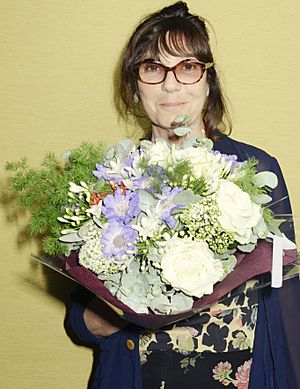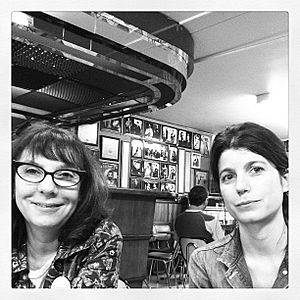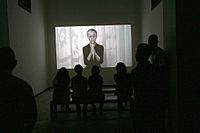Sophie Calle facts for kids
Quick facts for kids
Sophie Calle
|
|
|---|---|

Calle in 2015
|
|
| Born | 9 October 1953 (age 72) Paris, France
|
| Known for | Conceptual art, installation art |
Sophie Calle (born October 9, 1953) is a famous French artist. She is known for her unique work as a writer, photographer, and artist who creates installations and conceptual art. Her father, Robert Calle, was also a well-known art collector.
Sophie Calle's art often explores human feelings and how we understand who we are. She is famous for her projects where she acts like a detective, following strangers or looking into their everyday lives. Her photographs often come with her own written stories, making her art very personal.
Since 2005, Calle has been a professor of film and photography at the European Graduate School in Switzerland. She has also taught at other universities, sharing her knowledge with new artists.
Her artwork has been shown in many important museums and galleries around the world. These include the Centre Georges Pompidou in Paris, the Hermitage Museum in Russia, and the Whitechapel Gallery in London. She even represented France at the Venice Biennale in 2007, which is a very big art event.
In 2019, Sophie Calle received the Centenary Medal from the Royal Photographic Society. This award recognized her important contributions to photography.
Contents
Exploring Sophie Calle's Art
Sophie Calle's projects often involve interesting rules or challenges she sets for herself. She uses these rules to explore ideas about privacy, identity, and how people connect.
Early Projects (1979–1981)
Suite Venitienne (1979)
In this project, Sophie Calle followed a man she met in Paris all the way to Venice, Italy. She wore a disguise and secretly photographed him as he moved around the city. Her work included black and white photos with text, showing her observations of his life.
The Sleepers (1979)
For The Sleepers, Calle invited different people to sleep in her bed. Some were friends, others were strangers. She would serve them food and take their pictures every hour. This project explored ideas about intimacy and trust.
The Hotel (1981)
Calle took a job as a chambermaid in a hotel in Venice for her project The Hotel. This allowed her to explore the rooms and see the personal items and writings left by guests. She used these observations to create art that gave a peek into the lives of people she didn't know.
Mid-1980s Works
Address Book (1983)
This project caused a lot of discussion. Sophie Calle found an address book and, after making copies and returning it, she called some of the numbers inside. She spoke to people about the address book's owner, a man she had never met. She then wrote about these conversations and added photos related to his favorite activities. This created a portrait of the man through the eyes of his friends. The owner felt his privacy was invaded, which led to a public disagreement.
The Blind (1986)
For The Blind, Calle interviewed people who were blind. She asked them to describe what beauty meant to them. She then created photographs that showed her artistic interpretation of their ideas of beauty. She also included portraits of the people she interviewed.
Birthday Presents Project
Sophie Calle has also created art from her own life. She made detailed displays of all the birthday presents she received over the years. This project was even mentioned in a book by Grégoire Bouillier, who described a party where he was the "mystery guest" for Calle's birthday.
Art in the 1990s
The Erouv of Jerusalem (1996)
In 1996, Calle asked people from Jerusalem (both Israelis and Palestinians) to show her public places that felt very personal to them. She explored how a person's own story can make a public space feel private. This project was inspired by a Jewish law called the eruv, which allows a public area to be treated as private for certain religious purposes.
No ... Last Night (1996)
Calle made a film called No ... Last Night with photographer Gregory Shephard. It showed their road trip across America, ending with them getting married in Las Vegas. The film explored what happens when two people who barely know each other go on a very personal journey together.
Leviathan and Double Game
The famous writer Paul Auster asked Sophie Calle to be the inspiration for a character named Maria in his 1992 novel, Leviathan. Calle was so interested in this mix of real life and fiction that she created the artworks that the fictional character Maria made. These works, including meals arranged by color, are shown in Calle's book Double Game (1999).
The Gotham Handbook (1998)
Paul Auster also challenged Calle to take care of a public telephone booth in New York City. Calle added a notepad, water, cigarettes, flowers, and money to the booth. Every day, she cleaned it and restocked the items. This project, which explored public space and helpfulness, is documented in The Gotham Handbook.
Room with a View (2002)
In 2002, Sophie Calle spent a night sleeping in a bed placed at the very top of the Eiffel Tower in Paris. She invited people to come and read her bedtime stories to help her stay awake all night. This unique project explored ideas of public display and personal experience.
Works from the 2000s
Douleur Exquise (2003)
This project, meaning "exquisite pain," explored heartbreak. Calle traveled to Japan, taking a long train journey through Russia and China. She was supposed to meet someone, but they didn't show up. She took a photograph every day leading up to the meeting and wrote about her excitement. The second part of the project focused on her sadness after the disappointment. She wrote about her painful memory on one page and asked others to share their worst memories on the opposite page. Over time, her own story became shorter as her pain lessened.
Take Care of Yourself (2007)
At the 2007 Venice Biennale, Calle presented Take Care of Yourself. This artwork was inspired by a breakup email she received, which ended with the words, "take care of yourself." Calle asked 107 women from different professions to interpret this email. They analyzed it, commented on it, danced it, and even sang it. This project was her way of dealing with the breakup and understanding it from many different viewpoints. It became a powerful piece about women and modern feminism.
Major Exhibitions (2009-2010)
A large exhibition of Sophie Calle's work, including Take Care of Yourself, The Sleepers, and Address Book, opened at the Whitechapel Gallery in London in 2009. Another big exhibition was held in Denmark at the Louisiana Museum of Modern Art in 2010.
Art in the 2010s
True Stories (2011)
In 2011, Calle's work True Stories was shown at the historic 1850 House in New Orleans. This museum house is set up to look like it did in the mid-19th century. Calle placed her own personal objects and short stories throughout the house, making it seem as if she had just left before visitors arrived. This made people think about history and personal memories.
Rachel, Monique (2014)
In 2014, Calle's work Rachel, Monique was displayed in New York City. It included videos she took of her mother, Monique Sindler, as she was dying. It also featured parts of her mother's diary, read by actress Kim Cattrall. Calle later took her mother's portrait and jewelry and buried them at the North Pole, with photos of this act also being part of the exhibition.
Here Lie the Secrets of the Visitors of Green-Wood Cemetery (2017)
In 2017, Sophie Calle created a public artwork for Green-Wood Cemetery in Brooklyn, New York. This piece, called Here Lie the Secrets of the Visitors of Green-Wood Cemetery, will stay in the cemetery for 25 years. It invites visitors to write down their secrets and place them in a special tombstone.
Recent Works (2020s)
On the Hunt (2024)
In 2024, a new project by Calle called “On the Hunt” was shown. This work featured dating advertisements from a French hunting magazine, dating from 1895 to 2019. It showed how men's interests in partners changed over time. Alongside these quotes, there were images of hunted animals and hunting towers.
Awards and Recognition
Sophie Calle has received several important awards for her art:
- 2010: Hasselblad Award
- 2017: Shortlisted for the Deutsche Börse Photography Prize
- 2019: Centenary Medal, Royal Photographic Society
- 2024: Praemium Imperiale
Gallery
See also
 In Spanish: Sophie Calle para niños
In Spanish: Sophie Calle para niños





